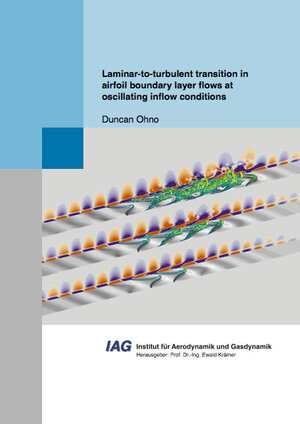Laminar-to-turbulent transition in airfoil boundary layer flows at oscillating inflow conditions
von Duncan OhnoThis thesis numerically investigates the laminar-to-turbulent transition in boundary-layer flows on natural laminar flow airfoils under oscillating inflow conditions. Large-scale fluctuations in the form of periodic vertical gusts generate an oscillating pressure gradient, resulting in a complex transient behavior of the boundary layer. Under these conditions, two scenarios are investigated: an attached flow with natural Tollmien-Schlichting (TS) wave transition and a boundary-layer flow featuring a laminar separation bubble (LSB). The study aims to provide a deeper understanding of the transient mechanisms involved as well as the basis for new transition prediction methods for unsteady conditions.
Direct numerical simulations (DNS) are performed where the gust disturbance is imposed on the fully-resolved transitional boundary layers via unsteady boundary conditions. In this novel approach, transient base flows are generated in advance with unsteady Reynolds-averaged Navier-Stokes (URANS) simulations of entire unsteady airfoil flows in conjunction with the disturbance velocity approach (DVA) to introduce sinusoidal gusts. The spatio-temporal evolution of the modal disturbances is analyzed using the continuous wavelet transform (CWT), which is then compared with linear stability theory (LST) by employing a trajectory-following method for transient flows.
Several physical effects responsible for the transient characteristics of the studied flows are identified and observations from previous experimental studies are classified. The results demonstrate that the quasi-steady linear theory adequately predicts the transient behavior of the convective modal disturbances for a wide range of gust perturbations. The so-called convective-transition mode with a subsequent calmed region is found for cases with a high degree of unsteadiness. This study is the first to provide a physical explanation for the occurrence of this mechanism for natural transition.
Direct numerical simulations (DNS) are performed where the gust disturbance is imposed on the fully-resolved transitional boundary layers via unsteady boundary conditions. In this novel approach, transient base flows are generated in advance with unsteady Reynolds-averaged Navier-Stokes (URANS) simulations of entire unsteady airfoil flows in conjunction with the disturbance velocity approach (DVA) to introduce sinusoidal gusts. The spatio-temporal evolution of the modal disturbances is analyzed using the continuous wavelet transform (CWT), which is then compared with linear stability theory (LST) by employing a trajectory-following method for transient flows.
Several physical effects responsible for the transient characteristics of the studied flows are identified and observations from previous experimental studies are classified. The results demonstrate that the quasi-steady linear theory adequately predicts the transient behavior of the convective modal disturbances for a wide range of gust perturbations. The so-called convective-transition mode with a subsequent calmed region is found for cases with a high degree of unsteadiness. This study is the first to provide a physical explanation for the occurrence of this mechanism for natural transition.






